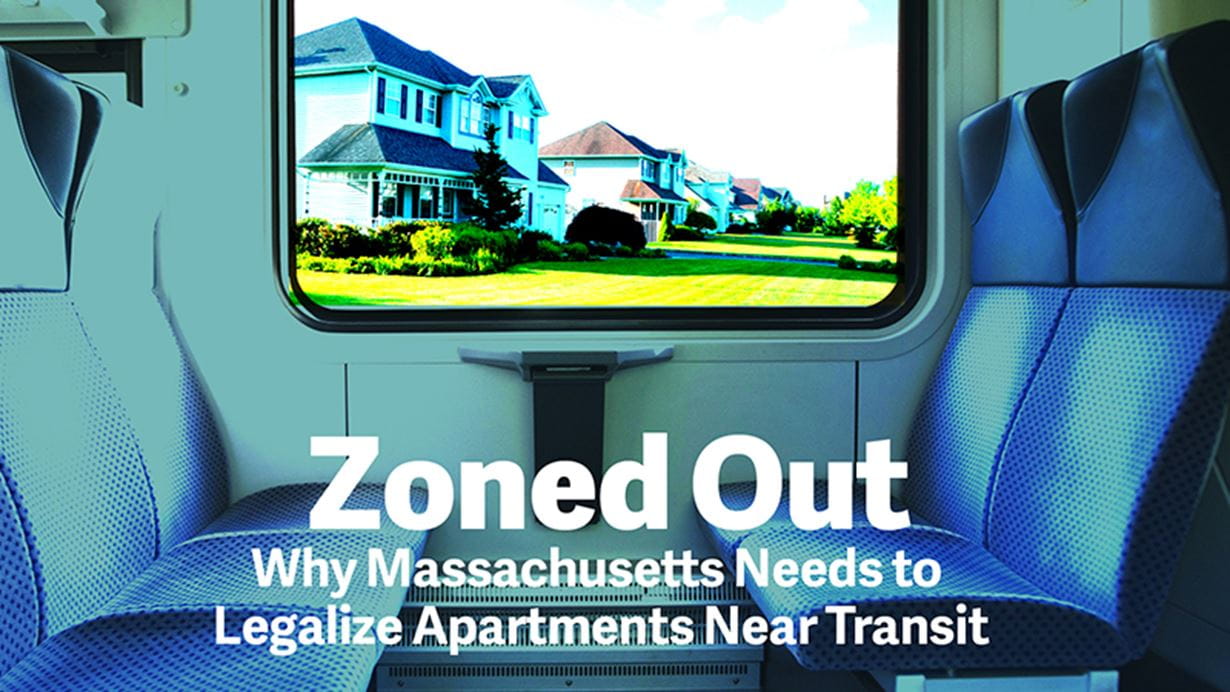With the understanding that in practice, such a policy change would involve complexity, and even if fully implemented would only be part of a complete solution, researchers Luc Schuster and Trevor Mattos from Boston Indicators and Jenny Schuetz and Sarah Crump of the Brookings Institution made the case. They explained how this one change could chip away at the tripartite problem of housing scarcity and high cost, car dependence and climate change, and residential segregation.
They looked at four station stops in suburbs—all within a 30-minute ride to downtown Boston—dominated by single-family housing, currently the only type of construction allowable there by right. Today, homeowners or developers who buy property within a walkable radius of these train stops can, with ordinary permitting processes, tear down an old house and erect a mansion. What if, instead, they could—with the same permitting process—build a duplex, a set of three or four townhouses, or even a low-rise condo building?
Researchers crunched the numbers to show that it would be profitable enough to interest developers, without government subsidy. It would increase the affordability of housing near transit in the most affluent communities, allowing people to live there—people who may even work in the town—who could never dream of affording to live there now. In areas where housing was at less of a premium, new multifamilies were in the same price range as existing homes, but still added to the region’s stocks, and to potential transit vitality. The change would be evolutionary, but in five years, if only five percent of single-family lots transitioned to multifamily use, there’d be a few hundred new units—in most cases exceeding the number of new units built across the entire municipality over the preceding five years.
All of these details are described and diagrammed in the Zoned Out report, which ends with a look at several similar efforts around the country to address regional housing shortages with changes to zoning rules. Oregon was a leader, being the first state in the nation to eliminate exclusionary single-family zoning statewide. One of the advocates for the legislation and former Policy Director for the Oregon House Speaker, Taylor Smiley-Wolfe, joined the conversation after the research presentation, along with Boston’s Jarred Johnson, Director and COO of Transit Matters, and Janelle Chan, Senior Policy Fellow at the Massachusetts Housing Partnership.
Smiley Wolfe talked about the lessons learned in Oregon. Briefly, such a change needs championing by key elected officials, a willingness on all advocates’ part to persist, and strong coalitions—often made up of strange bedfellows, such as tenants’ rights organizations, AARP, racial justice organizations and associations of realtors, to name a few of the disparate players in Oregon’s journey. She cited research showing that “with more state involvement, there’s less residential segregation by income—and usually by race,” but added, “displacement concerns around zoning change are real, so it’s key to pair tenant protection with supply side changes.”
From the transit-focused view, Jarred Johnson has his eye on global best practices for commuter rail, and pointed to the Bay Area Rapid Transit’s involvement in development on train-adjacent land. BART has some influence in shaping development for appropriate density considering train service and other contexts. Janelle Chan was grateful for the optimism shown in presenting a study on transit-oriented development when the pandemic has normal train use in suspended animation. “The need is real, but… there’s a lot of will to not build, and a lot of loopholes. We need more incentives for cities and towns to play ball,” she suggested.
Another glimmer of optimism about making changes in these fraught times came through Schuster’s framing of the problem. “My sincere sense is that most of the people living in the suburbs that we focus on in this report did not consciously intend their communities to be built out in this way,” he said, referring to their segregation-inducing zoning. “This is a moment when many of us feel inspired to take action to address racial and economic injustice…. I think reforming our state’s approach to zoning offers a really tangible opportunity to advance racial equity in our own back yards, and could position us to become real leaders nationwide.”
Click here to read the first Big Idea report: A Guaranteed Income for Massachusetts.



